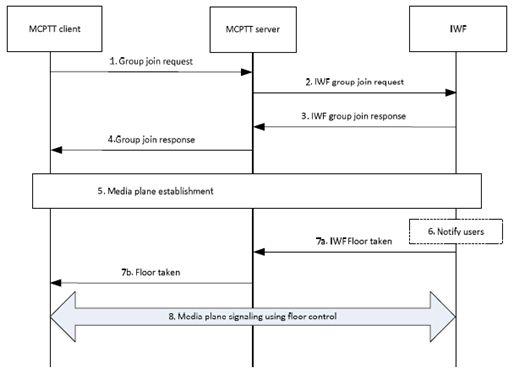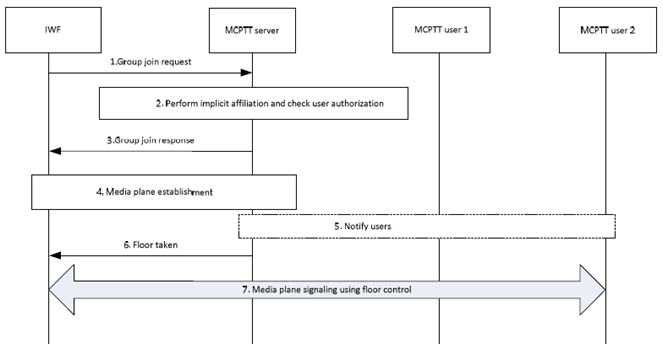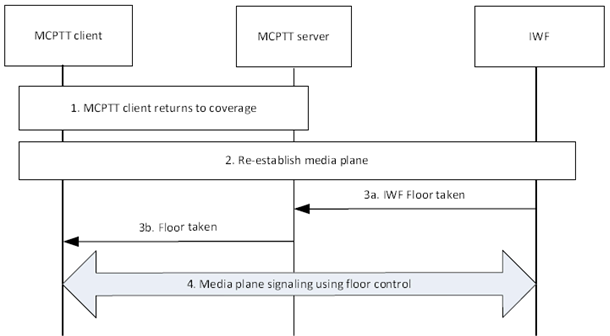Content for TS 23.283 Word version: 18.1.0
1…
10…
10.2…
10.2.2…
10.2.3…
10.3…
10.3.3…
10.3.3.7…
10.3.4…
10.3.4.4…
10.3.5…
10.3.5.8…
10.3.6…
10.3.7…
10.3.7.5…
10.3.8…
10.4…
10.4.4…
10.5…
10.5.7…
10.6…
10.6.2…
10.6.2.3…
10.6.3…
10.6.4…
10.7…
10.8…
10.11…
10.11.4…
10.12…
10.14…
10.15…
10.3.5.8 Newly joined MCPTT group member of a group defined in the LMR system
10.3.5.9 Newly joined LMR group member of a group defined in the MCPTT system
10.3.5.10 MCPTT client returning to coverage on a group homed in the LMR system
...
...
10.3.5.8 Newly joined MCPTT group member of a group defined in the LMR system |R16| p. 67
Procedures in Figure 10.3.5.8-1 are those for a group member entering an ongoing MCPTT group call, i.e. performing a late entry.
Pre-conditions:
- The MCPTT client is registered and the MCPTT user has been authenticated and authorized to use the MCPTT service.
- There is an ongoing group call on the group homed on the LMR system.
- The MCPTT client has not yet joined the group call.
- The MCPTT user indicates to join the group call.

Step 1.
The MCPTT client sends a group join request with the MCPTT group ID of the desired group to the MCPTT server. If there is a request to transmit, then the group joint request contains an indication of an implicit floor request.
Step 2.
The MCPTT server forwards the request to the IWF.
Step 3.
The IWF replies with a group join response indicating the acceptance of the group join request.
Step 4.
The MCPTT server forwards the response to the MCPTT client.
Step 5.
The IWF establishes the media plane with the MCPTT client.
Step 6.
The IWF may notify its users that an MCPTT user has joined the group.
Step 7a.
The IWF sends an IWF floor taken (for the current talker) to the MCPTT server if the floor has been taken.
Step 7b.
The MCPTT responds to any incoming IWF floor taken message by forwarding a floor taken message to the MCPTT client.
Step 8.
Floor control will continue to be used by the floor participants.
10.3.5.9 Newly joined LMR group member of a group defined in the MCPTT system |R16| p. 68
Procedures in Figure 10.3.5.9-1 are those for the IWF entering an ongoing MCPTT group call, i.e. performing a late entry.
Pre-conditions:
- MCPTT user 1 and MCPTT user 2 have previously joined to the group.
- MCPTT users using MCPTT client 1 and MCPTT client 2 are in an ongoing group call.
- The IWF has not yet joined the group call.

Step 1.
The IWF sends a group join request with the MCPTT group ID of the desired group and either using the MCPTT ID corresponding to the LMR group member or using the pre-configured MCPTT ID for use when the IWF is affiliating itself on behalf of the group's LMR users. If there is a request to transmit, then the group join request contains an indication of an implicit floor request. If the group join request includes an implicit floor request it may also include location information.
Step 2.
The MCPTT server receives the group join request. MCPTT server generates an implicit affiliation using the MCPTT ID used by the IWF (if the IWF or the LMR user is not already affiliated to the group) and verifies that IWF is authorized to affiliate to the group.
Step 3.
The MCPTT server replies with a group join response indicating the acceptance of the group join request.
Step 4.
The MCPTT server establishes the media plane between the IWF and the MCPTT server.
Step 5.
MCPTT users at MCPTT client 1 and MCPTT client 2 may be notified about the IWF joining the group call.
Step 6.
The MCPTT server sends a floor taken (for the current talker) to the IWF.
Step 7.
Floor control will continue to be used by the floor participants associated with MCPTT client 1, MCPTT client 2 and the IWF.
10.3.5.10 MCPTT client returning to coverage on a group homed in the LMR system |R16| p. 69
Procedures in Figure 10.3.5.10-1 are those for an MCPTT client returning to coverage during an ongoing MCPTT chat group call.
Pre-conditions:
- The MCPTT user using an MCPTT client is in an ongoing chat group call when the MCPTT client goes out of radio coverage.

Figure 10.3.5.10-1: Late entry of a MCPTT client returning from out of coverage
(⇒ copy of original 3GPP image)
(⇒ copy of original 3GPP image)
Step 1.
The MCPTT client or MCPTT server detects that MCPTT client has returned to coverage.
Step 2.
The media plane between the MCPTT client and the IWF are re-established using media plane control signalling
Step 3a.
The IWF sends an IWF floor taken to the MCPTT server if anyone currently has the floor.
Step 3b.
The MCPTT server forwards a floor taken message to the MC Client if anyone currently has the floor.
Step 4.
Floor control will continue to be used by the floor participants.